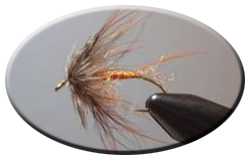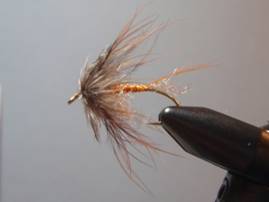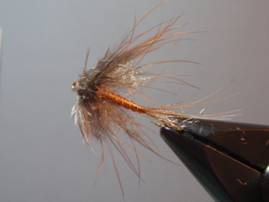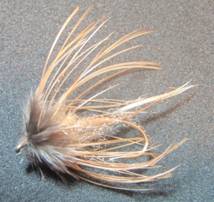COYOTED PHEASANT SOFT-HACKLE
Friends of mine, a couple that reside by Jefferson River at Three Folks, MT, sent me some pheasant feathers as a Christmas gift (partly joke so I can tie some flies for free). They say the bird would have been killed by a coyote in their property (but I know they are good hunters). Those feathers seemed to me from shoulder, probably from hen (softer than cocks'), along with after shaft plumes. These plumes meant more than a joke to me and really turned me on too design a fly. I came up with a synthesis of "traditional looking", "durability", "modern materials", and "existing patterns".
For "traditional looking", I used pheasant fibers for tail and hackle (partridge can be substituted for #12 & 14, if you try) and Gossamer silk for a thin body. For "durability", I added a rib of gold wire to protect the silk thread. Then I used Zelon strings for under-tail and -wing as "modern materials". Finally the use of aftershaft plumes to form a neat head and the whole design were based on "existing large soft-hackle patterns" with my best respect to innovators.
Spending lots of times at my tying bench, I have found out that cock's ramp feather to match the proportion is the best hackle, especially because not everyone has access to the hen's shoulder killed by coyotes.
This fly is primarily designed to target for fall-run brown and rainbow trout at Madison River in Yellowstone National Park. Also this should imitate drowned stonefly, October Caddis, and even a baby trout/minnow with an orange belly at right spots and times.

Materials:
- Hook: TMC 2302, Dai-Riki 280, or MFC 7231 #8 – 12
- Thread & Body: Pearsall's Gossamer silk orange
- Under-tail: Strands of tan Zelon (Darlon, Z-Yarn)
- Tail: Pheasant fibers
- Rib: Gold or copper wire, medium for #8 and small for #10 and smaller
- Under-wing: Strands of tan Zelon (Darlon, Z-Yarn)
- Hackle: Hen pheasant shoulder or cock's rump
- Head: Pheasant aftershaft
How to Fish: It works most effectively with a floating line at riffles and pools. It should be fished by the traditional down-stream wet-fly swing then strip-&-twitch, as if streamers, every now and then. Also it's been proven to work to be fished as a dropper under dry-flies. Twitch and figure-8 retrieve after dead-drift!!



Step 1: Apply Beeswax to Gossamer before wrapping. Start wrapping from thorax position to avoid the excess bulk around head later. Wrap to just above the hook point.
Step 2: Tie in a tuft of Zelon, half length of the shank, and some fibers from pheasant, length of hook shank. Then tie in wire. At this point, do not worry the bulk of all of these tying points.
Step 3: Wrap Gossamer to the thorax position, forming a nicely tapered body, and followed by ribbing wire.
Step 4: Tie in a tuft of Zelon with figure-eight wraps and sweep back on both sides. Trim it on both sides for the body length. Gossamer body and Zelon under-wing essentially make a thorax for this fly.
Step 5: Tie in a hen shoulder or cock ramp feather and wrap two turns.
Step 6: Tie in a Pheasant aftershaft plume and form a nice and soft head. Apply Beeswax on Gossamer, so you don't have to use cement, whip finish.
| Editors Note |
|---|
| Satoshi Yamamoto, brought his passion for fly-fishing & fly-tying from Japan to Montana and became the first ever Japanese guide in Livingston/Bozeman area. He fishes big rivers like the Madison & Yellowstone, spring creeks in Paradise Valley, and various waters in Yellowstone National Park. Hence, with his Regal Vise at the bench, his fly tying interests vary from tiny midges to 5-inch streamers and anything in between. Once his ideas are combined he goes out to experiments at those near-by waters. Satoshi submits his innovative patterns to Montana Fly Company. He has a Masters' in Animal Science from Montana State University and is a professional cattle breeder when not guiding. |
For more great info, check out:
Beginning Fly Tying | Intermediate Fly Tying | Advanced Fly Tying.
